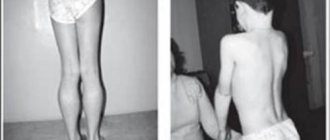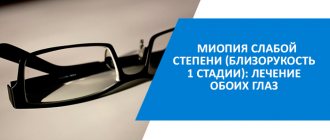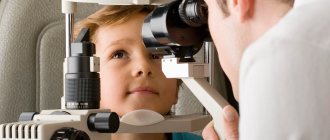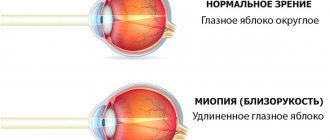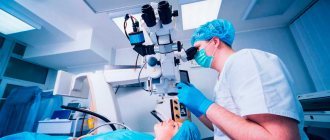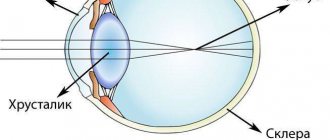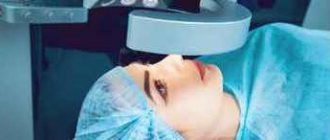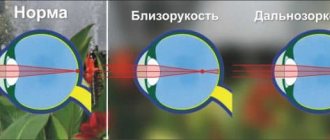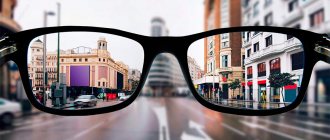Diagnosing a disease such as myopia reveals not only the causes of its formation, but also the factors accompanying its constant development. What affects vision deterioration and how to stop this detrimental process to your health in order to see the beauty of the world without distortion. Let's talk about methods for preventing the progression of myopia.
In this article
- Myopia - what is it?
- Degrees of myopia
- The range of causes of the occurrence and development of myopia
- Factors associated with the rapid development of myopia
- Poor visual hygiene
- No treatment for myopia
- Wrong choice of optics
- Lack of vitamins and microelements
- Age-related changes
- Diseases and myopia
- Pressure
Myopia - what is it?
Myopia, or otherwise myopia, is a disorder in the visual system, which is characterized by good visibility of objects near and insufficient visibility at a distance. As a result of the disease, the eyeball is deformed - it lengthens and takes on an oval shape. Rays of light passing through the visual organ are focused in front of the retina, rather than on it, creating a blurry picture. Aristotle became interested in the phenomenon of myopia, who noticed that some people, due to the peculiarities of their vision, begin to squint when they look into the distance. Hence the name translated from ancient Greek - “squinting” and “look”, “vision”.
Myopia happens:
- congenital;
- hereditary;
- acquired;
Congenital myopia is detected immediately after birth if deformations of the eyeball are detected. Hereditary myopia is a pathology transmitted from parents, which will be discussed below. Acquired is the most common type of myopia, which developed due to excessive strain on vision and non-compliance with the recommendations of the ophthalmologist.
Features of playing sports for myopia and farsightedness
Myopia (myopia, from the Greek “myo” - to squint and “opsis” - to look) is a change in the shape of the eye from round to oval, due to which the refraction of light within it is disrupted, and light rays passing through the eyeball are focused in front of the retina, and not on her. Therefore, nearsighted people see objects that are far away as blurry. In this case, the retinal cells located in the zone of maximum light sensitivity are rarefied and stretched. This is the main reason why doctors prohibit activities related to jumping, hitting, straining and the possibility of getting a traumatic brain injury - due to the high risk of retinal rupture or detachment.
With farsightedness, for example, the eye is not elongated, but flattened, and the retina does not stretch as critically as with myopia. Therefore, farsighted people in sports are almost always given the green light, at least by ophthalmologists.
However, the diagnosis of “myopia” itself is not a final verdict that puts an end to sports activities. Firstly, it can be congenital and acquired. The second, naturally, is more dangerous.
Secondly, the degree of myopia matters. Officially distinguish:
- weak myopia – up to 3 diopters
- average myopia – from 3 to 6 diopters
- severe myopia – above 6 diopters
Up to 3 diopters, as a rule, there are no restrictions on physical activity. From 5 diopters - doctors are cautious in giving permission to play sports, even in the absence of degenerative changes in the fundus. In this case, novice athletes will have to forget about weightlifting, boxing, all types of wrestling, acrobatics and artistic gymnastics. Over 6 diopters is the maximum limitation, regardless of sports ranks and achievements.
Thirdly, this gradation is very arbitrary, since with -1 vision you can have progressive myopia (when it increases by one or more diopters per year). Then the doctor will think carefully about what conclusion to give you. Or you can walk around with -3 all your life, do boxing, wrestling and lifting iron, and your eyes will feel great. Well, maybe not exactly excellent, but no less than -3.
And fourthly, to summarize the previous two points, restrictions on playing sports are imposed not in accordance with the degree of myopia, but based on changes inside the eye. For example, it is much worse and more dangerous when, with weak myopia, hemorrhages are visible in the fundus of the eye and the retina is weakened than a stable condition with average myopia.
If your myopia does not progress, you should definitely engage in some kind of sport. If it is impossible to play sports with glasses and contact lenses, then you can take off your glasses during exercise. If you cannot use glasses, but visual acuity is necessary, then in such cases you need to use contact lenses worn directly on the eyeball.
When myopia develops, you cannot engage in sports with great physical stress (boxing, wrestling, weightlifting, etc.).
If a person has myopia of more than 4 diopters, then doctors should not allow him to play sports. Myopia may progress during exercise, in which case the athlete should stop playing sports or reduce the load.
Playing sports can have a positive effect on vision stabilization. Sports games, swimming, skiing, and mountain sports give them great advantages.
When physical activity is limited, myopic people experience a deterioration in the blood supply to various organs, including the eyes, and a deterioration in the ability to accommodate. However, as the researchers note, not all physical exercises will be beneficial for people with myopia. The most useful are cyclic exercises of medium intensity (running, swimming), in which the heart rate remains at the level of 100-140 beats per minute. By causing blood flow to the eyes, these exercises improve the functioning of the ciliary muscle of the eye and normalize the circulation of intraocular fluid. High-intensity cyclic exercises, as well as acrobatics, jumping, exercises on gymnastic apparatus, causing an increase in heart rate up to 180 beats per minute, lead to significant long-term ocular ischemia, and are therefore contraindicated for myopic people.
A decrease in general physical activity and physical inactivity, combined with significant visual stress, which is often found among schoolchildren and students, contributes to the development and progression of myopia. To prevent the occurrence and treatment of myopia in children and youth, a combination of physical exercises aimed at general development with special exercises that improve blood supply to the eyes and cause strengthening of the ciliary muscle is recommended.
Degrees of myopia
Before moving on to a detailed analysis of the causes of visual impairment, it is worth learning about the degrees of development:
- weak - up to 3 diopters;
- average - 3-6 D;
- high - 6-30 D.
With mild myopia, the length of the eye is not yet sufficiently changed - about 1.5 mm, which is still higher than normal. With a low degree, you can see fairly well up close, but objects in the distance are a little blurry.
An average degree of myopia means significant changes in the visual system. The length of the eye can be increased to 3 mm. Visibility near is limited to 30 cm, and then greatly decreases.
The most dangerous is a high degree of myopia, as it reaches 30 diopters. Changes occur in the structure of the fundus, retina and choroid. Vision is reduced to 100%, and visibility to 10 cm.
True or false?
Ophthalmologists divide myopia into true and false. The first type is in which the shape of the eyeball actually changes, the second is a spasm of accommodation that occurs due to overwork of the eye muscles, and which is not myopia. False myopia can turn into true myopia if you continue to keep the eye muscles in constant tension, but true myopia, unfortunately, cannot turn into a spasm of accommodation.
Treatment of mild myopia
Treatment includes the use of several therapies, depending on the degree of disease progression. If mild myopia is diagnosed, treatment is carried out using conservative methods. Vitamins are prescribed as healing drugs:
- A - promotes normal functioning of the retina;
- B1 - regulates metabolism in the body;
- B2 - relieves eye tension;
- ascorbic acid - helps strengthen the sclera of the eyes;
- nicotinic acid - improves blood circulation, dilating blood vessels.
These drugs are available for oral administration and as eye drops. To strengthen the blood vessels and walls of the structure of the organs of vision, medications containing calcium are prescribed:
This visual problem causes nearby objects to be clearly visible, but distant objects to be blurred. This is due to an increase in the anteroposterior diameter of the eye. Accustomed to innate ones. This may be accompanied by an increase in the curvature of the cornea or one or both sides of the lens. This is due to late acquired myopia.
It is provoked by a change in the refractive index of the aqueous or vitreous body. Usually this is acquired senile myopia. In the vast majority of cases and generally in the most intense forms, myopia is of the axial type. Myopia is clinically classified as benign or simple myopia and pathological or degenerative myopia.
- Trental;
- Rutin;
- Calcium gluconate.
To prevent eye spasm, use drops: Mezaton, Irifin. Physiotherapeutic procedures help stop the development of pathology.
First degree myopia can be treated with laser eye correction. This modern operation reduces the curvature of the cornea using strong radiation. Pathology of mild and moderate severity can be corrected. In preparation for surgery, a thorough examination of the condition of the cornea of the eye is carried out.
Simple myopia is a condition of limited progression in which the refractive error does not exceed 6 diopters and does not cause problems in the day. On the contrary, with pathological myopia the process is obviously more serious, since the fundus changes. In this case, the refractive index exceeds 6 diopters, and the pathology can rapidly increase to such an extent that it deserves attention as a separate clinical entity. The etiology of pathological myopia is not entirely clear. In general, scleral weakness and its subsequent inability to withstand intraocular pressure without recoil and expansion were addressed.
All data is entered into a computer, which makes calculations for the operation. The procedure is carried out on the basis of a developed program, so the risk of error is minimized. The patient is instilled with drugs to relieve sensitivity and dilate the pupil, the head and eyelids are fixed, and the necessary incisions are made to the cornea.
Fund changes have been recognized as being caused by this stretching, but most likely they are usually associated with a genetic developmental defect that affects the entire posterior segment of the eye. Whatever the cause, it is likely that the main disadvantage of myopia is developmental change. Thus, this seems to point to the fact that this process, although rarely congenital, can occur early and is usually hereditary.
We can say that myopia develops only during the period of active growth of a person, since elongation of the eye, which remains at normal size until the age of 25, is very rare. The eye shares with the brain the characteristic of growing earlier than the rest of the body, and by age 20 the eye and brain have already reached their adult size. It has been suggested that myopia is a consequence of the continuity of this prematurity due to the lack of a moderating influence.
The operation lasts a few minutes, then the patient returns home. After the procedure, you must follow all the doctor’s instructions: drop antibiotics into your eyes, sleep only on your back in the first days, and maintain eye hygiene. This manipulation allows you to cure myopia and restore eye vigilance.
The range of causes of the occurrence and development of myopia
Let us list the main anatomical and physiological causes of myopia, the factors contributing to its development, and then consider each of them in detail.
Ophthalmologists name two main causes of myopia:
- Elongated axis of the eyeball. The refractive optical power of the visual organ does not correspond to the length of the axis, this leads to an insufficiently clear image with subsequent stretching of the posterior wall of the eye, which is fraught with significant changes in the macular area and even retinal detachment.
- Strong refraction of light rays. The optical system of the eye is responsible for these functions: the cornea and lens. Even with a standard size of the eyeball, the strong refraction of light rays by the optical apparatus leads to the fact that the image does not reach the retina, focusing in front of it.
Factors associated with the rapid development of myopia
- Hereditary predisposition;
- birth injuries;
- head injuries;
- high pressure;
- lack of vitamins and microelements;
- weakening of the muscles of the visual organ, overstrain;
- other visual defects (astigmatism, strabismus);
- causes caused by eye strain;
- lack of appropriate treatment when myopia is detected;
- incorrect selection of correction means;
- hormonal disorders and infectious diseases;
- age.
Heredity
Most often, myopia is a hereditary disease. If both parents have mild or moderate myopia, then with a high degree of probability (75-100%) the child will also have it. If both parents have high myopia, then the children will also suffer from this disease with a 100% probability. If only one of the parents is sick, the chances are significantly reduced. Only 8% of children whose parents have normal vision develop myopia. In this situation, when only one of the parents has myopia, the child may never suffer from this disease.
Injuries
Suffered eye injuries, including birth injuries to newborns, accompanied by damage to the visual zone, without a doubt, can cause visual defects, namely myopia. This item includes traumatic brain injuries that can affect the ability to see, as well as labor.
Women with a high degree of myopia may be prohibited from giving birth naturally, as there is a high risk of losing their vision completely. Women with mild or moderate myopia after natural childbirth experienced a decrease in vision to 1-1.5 diopters, which can be explained by significant overstrain of the eye muscles during pushing.
Methods for treating high myopia
In medical science, there are several methods of therapy that improve vision and, accordingly, the patient’s quality of life. The specific method of correction is selected by the ophthalmologist after examination. When choosing a treatment method for high myopia, various factors are taken into account: intraocular pressure, visual acuity, condition of the fundus, general anamnesis.
High myopia can be corrected in the following ways:
- Optical
. With high myopia up to 16 diopters, patients can wear glasses or contact lenses - constantly throughout the day. To make a person comfortable, the doctor selects lenses or glasses that correspond to the state of vision. - Laser correction
. Laser treatment is carried out if vision has dropped to -13 diopters. Sometimes laser correction is used at -15 D, but at higher degrees it will not be effective. The essence of the procedure is that the device makes a micro-incision in the cornea. Then the cells evaporate, as a result of which it acquires the correct shape, and vision returns to normal. There are several laser treatment options (LASIK, photorefractive keratectomy, and others). The specific option is selected by the ophthalmologist after examination. Patients aged 18-65 years are allowed for treatment. The laser correction procedure is irreversible. - Phakic correction.
The method is suitable for patients not only with extreme degrees of myopia (up to -18 diopters), but also with moderate degrees of myopia. Phakic intraocular lenses are made from a unique, highly biocompatible material for eye tissue - collamer, which includes collagen. They are implanted into the eye to reduce a person's need for glasses or contact lenses without removing the natural lens. An operation is performed for implantation. A small incision is made through which the phakic lens is inserted. This is an effective treatment method if myopia has reached the last degree, but the ability to accommodate remains. The phakic correction procedure is reversible. The lens can be replaced or removed if necessary.
Before choosing treatment, consult an ophthalmologist. It is necessary to undergo a detailed examination and accurately determine the degree of myopia in order to choose the appropriate technique. You can choose a clinic to visit here
Poor visual hygiene
Visual hygiene is a preventive measure that comprehensively addresses the issues of maintaining the health of the visual system and eliminating those factors that contribute to the progression of eye diseases. One of the most common factors in the rapid development of myopia is improper visual hygiene or even neglect of it. Let's look at the main mistakes:
- excessive load and overstrain of the visual organs due to spending many hours in front of a computer monitor, TV or gadgets;
- insufficient distance from the eyes to the monitor, book, tablet - less than 30 centimeters;
- lack of rest in the work of the visual zone;
- work in low light conditions;
- reading in a supine position, on your side, in a moving vehicle;
- incorrect posture when writing or reading;
- long-term painstaking work with small objects;
- neglect of eye protection from ultraviolet radiation.
These actions, when repeated daily, significantly accelerate the development of myopia. Together with heredity, neglect of visual hygiene can lead to a significant decrease in vision - up to 3 diopters per year. It’s worth thinking about whether those rules that were taught from childhood are really useless?
- do not read in the dark or lying down;
- do not watch TV closely;
- give your eyes rest every 40 minutes;
- do visual gymnastics 2 times a day.
With the lightning-fast development of smartphones and various computers, the percentage of people with visual impairments is increasing exponentially. Russian ophthalmologists are sounding the alarm - vision problems among the young working-age population are growing every year. According to the World Health Organization, currently about 253 million people in the world have visual impairments, of which 43% are uncorrected refractive errors such as myopia, farsightedness or astigmatism. 90% of these 253 million are in developed countries. We find time, effort and money for ultra-modern technology, but we neglect visual hygiene, which leads to the progression of eye diseases even from school.
But it’s not only progress and smartphone manufacturers that affect our vision. Excessive visual stress - for some, this is an integral part of professional activity, which inevitably leads to myopia.
Occupations at risk include:
- office worker;
- programmer;
- Auto Mechanic;
- teacher;
- master of manicure and eyelash extensions;
- driver;
- welder.
A person who is exposed to the risk of eye diseases at work, in order to prevent their rapid development, must take visual hygiene doubly seriously and be sure to include it in the work process.
No treatment for myopia
Such a visual impairment as myopia requires immediate treatment: it does not remind you of itself with unbearable pain, does not force you to forget everything to run to the pharmacy for medicine, but, nevertheless, it often surely and steadily leads to partial or complete loss of vision. We can postpone treatment indefinitely, resorting only to purchasing correction products that increase by one diopter every year. Hoping for modern laser surgery, many of those who are familiar with myopia first-hand think only about prompt resolution of the problem in the distant future, without caring about prevention and special treatment here and now.
The variety of spectacle optics and contact lenses allows you to choose the product that will make it possible to completely forget that you have vision problems. This is an aggravating factor in the development of myopia to a high degree. Only a combination of preventive measures will prevent the disease from developing rapidly, and they cannot be neglected.
Contraindications
Patients diagnosed with myopia should understand which sports they should absolutely not engage in. Even if an initial degree of myopia is diagnosed, heavy lifting, jumping and dismounts, somersaults and headstands, and jumping from a catwalk are contraindicated. It is forbidden to exercise with iron - lifting barbells, weights, dumbbells, discs. The list of contraindications also includes:
Myopic people should avoid horseback riding.
- karate;
- power struggle;
- shooting;
- Weightlifting;
- fast run;
- hockey;
- football;
- rowing;
- Horseback Riding.
Certain types of strength and intense exercise can increase blood pressure and intraocular pressure. With myopia, this condition is extremely dangerous, because it can cause detachment and deformation of the retina, ischemia of intraocular structures, complete loss of vision, after which the patient will forever remain disabled.
Wrong choice of optics
It is strictly forbidden to self-medicate for any disease. Eye diseases, including myopia, are no exception. Incorrectly selected glasses or contact lenses will significantly damage the visual system. Glasses or lenses - everyone makes their own choice, the main thing is that it is agreed upon with an ophthalmologist, who will write a prescription that matches your parameters. What is important to know when choosing vision correction products so as not to harm yourself, but rather to ensure the most comfortable living and working conditions? First of all, you need to remember that a prescription for eyeglasses is written by a doctor who can determine for you:
- interpupillary distance;
- number of diopters.
With these indicators, you can go to the nearest optician to select vision correction products. All you have to do is decide which frame and lens material suits you. There is room for imagination here, unlike the two points above. If you buy glasses without knowing your interpupillary distance, there is a high probability that you will not choose what suits you and risk deteriorating the quality of the visual zone even more. What are the risks of buying glasses without a prescription? When trying on glasses at an optician, you may think that you see well in them and that your eyes are comfortable, but you should not rejoice ahead of time. Wearing glasses with incorrect interpupillary distance every day can lead to astigmatism and squint.
Selecting contact correction products is even more complicated than buying glasses. In order to get lenses that perfectly suit your eyes, you need to take many features into account. Before purchasing contact optics for the first time, it is important to contact an ophthalmologist for a prescription, and then to a professional optician, where an optometrist will explain to you all the intricacies of handling the products.
What matters when choosing lenses:
- diameter;
- radius of curvature;
- disc thickness;
- moisture content indicator;
- throughput;
- material;
- life time;
As you can see, for the first purchase of lenses you simply need to consult a specialist. For subsequent ones, you will already know what exactly is suitable for your eyes, and you will not be mistaken with your choice. Conscious selection of optics, together with an annual visit to an ophthalmologist, eliminates one of the factors in the rapid development of myopia, as well as other vision defects.
Application of exercise therapy
If progressive myopia occurs, then the use of a set of appropriate exercises is often recommended. In this case, contraindications must be taken into account, since improper execution of the exercises can lead to various complications.
If a person is diagnosed with a high-grade disease, then performing strenuous physical exercise is contraindicated for him. In this case, the work and study regime for a person must be developed correctly. Exercise therapy should consist of moderate loads. Myopic people are allowed to engage in a variety of sports - running, skiing, swimming. If a person is diagnosed with myopia, then he is not recommended to visit baths and saunas. Patients are strictly prohibited from taking alcoholic beverages or any other substances that have a strong effect.
If there is a high degree of myopia, then the patient is not recommended to play sports. In this case, it is necessary to perform hygienic exercises for the eyes, the duration of which is approximately ten minutes. The set of exercises should be designed in such a way that a person can train not only the internal, but also the external eye muscles. It is strictly forbidden for the patient to perform various jumps and leaps during the course of the disease, as this may adversely affect vision. And it is also not recommended to perform exercises that strain your eyesight for a long period. Eye gymnastics should be done every day, which will have a positive effect on its effectiveness.
Only a doctor knows what myopia is and how to treat it correctly. That is why, when this disease appears, the patient should seek help from specialists. Only a doctor, after conducting an appropriate examination, will be able to prescribe the proper treatment to the patient, which will have a positive effect on the vision of a person with high myopia. The patient must constantly use correction methods.
Lack of vitamins and microelements
Thousands of treatises have been written by nutritionists, endocrinologists, nutritionists on the benefits of proper nutrition, and for many it becomes a discovery how our diet can affect not only the figure, heart and liver, but also the visual system. It would seem that from childhood we are instilled with a love for carrots as almost the only truly useful product for eye health. Let's figure out what nutritional recommendations ophthalmologists give for patients with myopia and other diseases of the visual system.
General recommendations:
- stop overeating and undereating;
- eat a balanced diet (proteins, fats and carbohydrates);
- stick to the regime;
- limit foods high in fat in your diet;
- minimize the consumption of sugar and simple carbohydrates;
- give up bad habits (excessive coffee consumption, smoking, alcohol);
- take vitamins.
Recommendations for vitamins to improve vision:
- Vitamin A or retinol is called the vitamin of vision, as it is part of the visual pigments of the retina. Plant foods are rich in provitamin A - carotene, from which vitamin A is formed. Carotene is found in carrots, spinach, lettuce and tomatoes. Retinol is found in butter, liver and egg yolk.
- Vitamin E is also good for vision and can be obtained in sufficient quantities from olive, corn and cottonseed oils. Wheat germ contains a lot of vitamin E.
- Vitamin C is undoubtedly beneficial for the visual system. You can get it from citrus fruits, currants, apples, bell peppers, and broccoli.
- Vitamin D, formed under the influence of the sun, improves vision. You can also compensate for its deficiency by consuming fish oil, dairy products, and fish.
- B vitamins: thiamine, riboflavin, pyridoxine, cyanocobalamin, as well as nicotinic acid, which must be taken additionally in case of an unbalanced diet.
If you are not sure that you are getting enough vitamins that are beneficial for vision from the foods you consume, their deficiency must be compensated for with vitamin-mineral complexes. The choice of such complexes is quite large in any pharmacy. An ophthalmologist can also give advice on which vitamins are right for you.
Age-related changes
Myopia can develop both in childhood and adolescence, and become a concern after 40. It is worth dwelling in more detail on both variants of the course of the disease.
Physiological myopia is a very common eye disease, the development of which is influenced by:
- heredity;
- excessive strain on the eyes;
- rapid growth.
If your child uses gadgets uncontrollably for a long time every day, then the progress of myopia will not take long to occur. Against the background of hereditary myopia, that is, if the parents also suffer from this disease, coupled with the rapid growth of the child in adolescence, the result will most likely be disappointing - he will soon need vision correction.
In this case, parents can instill proper visual hygiene and control the use of a computer and smartphone in order to protect the growing body of a child or teenager from the rapid development of the disease. You should also visit an ophthalmologist, who, if necessary, will write a prescription for suitable optics and give recommendations for treatment. Mild myopia in a teenager can be cured with an integrated approach and control from the parent, and this is best done before the disease develops into a medium or high stage.
Vision also changes after 40 years: myopia can gradually give way to presbyopia - this means that near objects will appear clearer than in the distance. Changing a plus to a minus, especially if at a younger age the myopia indicator was average or high, is not the best prospect for the future, so the best way out is constant care for eye health, an annual visit to an ophthalmologist, taking vitamins and proper correction.
Symptoms
You need to pay attention to the following symptoms:
- blurred image in the distance;
- the need to squint when trying to see objects located at a considerable distance;
- pain in the eyes;
- migraine;
- increased fatigue when working with the eyes.
The pathological condition is often accompanied by:
- thinning of blood vessels;
- retinal dystrophy;
- astigmatism.
Diagnosis of the disease most often occurs during primary school age. At the same time, myopia is best corrected.
In the absence of qualified treatment, myopia can progress quickly. By the time you reach adulthood, it is almost impossible to eliminate the problem using conservative methods.
Note to young mothers: massage for dacryocystitis of newborns.
Actively use gymnastics for treatment and prevention
A mydriatic used for diagnosis and treatment is Mydriacyl eye drops.
Diseases and myopia
Observations by ophthalmologists show that myopia often develops against the background of chronic, hormonal and infectious diseases. Diseases of the oral cavity and nasopharynx can lead to myopia: tonsillitis, adenoids, sinusitis.
Allergic and infectious: diphtheria, tuberculosis, measles, scarlet fever, infectious hepatitis. Diabetes mellitus, scoliosis, rickets and frequent acute respiratory infections can also bring myopia with them. It cannot be said that these diseases are always accompanied by visual defects. It is important to understand that myopia usually begins in people with low immunity, that is, sick and weaker people.
Pressure
Increased eye pressure is one of the main causes of complex myopia, which can develop into juvenile glaucoma. This form of myopia is rarer and is associated with congenital disorders of the eyeball; it should not be neglected, as it can lead to complete blindness. It is necessary to monitor the level of intraocular pressure. When a person reaches the age of 40, regardless of the presence of complaints, the level of ophthalmotonus is checked. Intraocular pressure is measured using a special tonometer. The average pressure should be from 10 to 21 mm. Hg Art.
However, you should not think that you are far from determining ophthalmotonus. It can be increased by eye strain, chronic stress, certain professional activities, and even excessive coffee consumption. The risk increases significantly by age 40, but symptoms such as:
- Pain in the eyes;
- state of "fog";
- change in corneal color;
- severe eye fatigue at the end of the day;
Thus, we can conclude that the development of myopia is influenced by many factors, and this disease has more than one cause. In order to clearly understand the picture of your visual system disorder, you need to contact an ophthalmologist in a timely manner, do not forget about visual hygiene, do not overstrain the eye muscles, eat right and lead a healthy lifestyle. In each individual case, the doctor, if the patient wishes, can advise or, on the contrary, prohibit laser vision correction or surgical intervention. To prevent a constant “fall” in vision, do not forget about effective eye gymnastics.
It helps to relax the muscles and continue working with renewed vigor. At the moment, even special applications have been developed for a smartphone or computer that offer ready-made warm-ups for the eyes - you just need to repeat the movements shown on the monitor. Take care of your vision, because we receive 80% of the information about the world around us thanks to it.
Symptoms and causes of the disease
Myopia can develop gradually or remain permanent.
- In the first case, myopia worsens the condition every year and can lead to complete loss of vision.
- In the second, if certain rules are followed, it responds well to treatment. The refractive properties of the eye are measured in diopters. With normal vision, the data is equal to 1. With myopia, they acquire negative numbers.
Depending on the severity of the disease, there are 3 degrees of pathology. Weak myopathy is the initial stage of the pathological process, when the results range from -1.25 to -3 diopters. With medium they reach 6, with high - more than 6 diopters.
In case of farsightedness, light rays are concentrated at a point behind the retina. Nearby objects appear blurry. This occurs when the eye is too short or the cornea is too flat. Hyperopia is partly genetic. Many children are born with a degree of farsightedness, but some can compensate through powerful eye muscles. These muscles compress and loosen the lens located just behind the cornea after the cornea begins to bend light. Some children's close vision improves as they get older.
Myopia of the 1st degree is manifested by headaches and rapid eye fatigue. Objects in the distance appear blurry, without clear outlines. The person begins to squint to sharpen the image. There is a desire to bring objects with small inscriptions closer. Midges and flashes may appear before your eyes.
Often, mild myopathy develops in children during adolescence.
During the period of formation of the body from 7 to 12 years, there is an intense load on vision associated with the beginning of the educational process.
Over the years, the eye muscles become less and less able to make the necessary placement. After sixty years of age, the vast majority of people find it difficult to distinguish the details. It becomes more common after age fifty. The lens becomes stiffer and thicker, and its placement is reduced.
Symptoms of farsightedness and complications
Hyperopia manifests itself as difficulty seeing objects clearly, headaches, and eye stress. We may think that visual impairment in an adult is easy to detect. If the newspaper letters you read every morning are becoming increasingly vague, you should understand. In fact, the process slows down for the brain to detect it. In the case of a child, farsightedness is often not detected. Some children born in a hypertropic state have never seen the following objects clearly and do not know that this is possible.
Main causes of myopia:
- heredity, if parents have vision pathology, there is a high probability of developing abnormalities in the child;
- lack of vitamins in the body due to poor nutrition;
- intense strain on the eyes during close contact with a computer, TV, reading and writing in poor lighting;
- chronic diseases;
- incorrect approach to the selection of lenses and glasses;
- increased intraocular pressure;
- trauma during childbirth;
- brain pathology;
- decreased accommodative function, which leads to elongation of the eyeball.
Hyperopic children can accurately see nearby objects by unconsciously turning their eyes. For these children, headaches, rather than blurred vision, constitute the main symptom of farsightedness. Current research links childhood farsightedness to poor school performance. Often we find that children who seem to lack interest in reading are slightly hypermetropic. Many people suffering from farsightedness have great difficulty reading. Fortunately, farsightedness does not usually affect your ability to move.
Diagnosis of hypermetropia
Ophthalmologists use the famous poster with increasingly strict letters, the Snellen board, to detect myopia, but this poster does not detect farsightedness. This is why farsightedness is not discovered by eye exams in school. A proper vision examination by an ophthalmologist or optician consists of sitting in a chair with a refractor device placed at eye level. We look at the poster through the device, and the doctor slides the lenses into view. This test can detect myopia.
To avoid the development of the disease, it is necessary to diagnose the pathology in the early stages and carry out vision correction.
